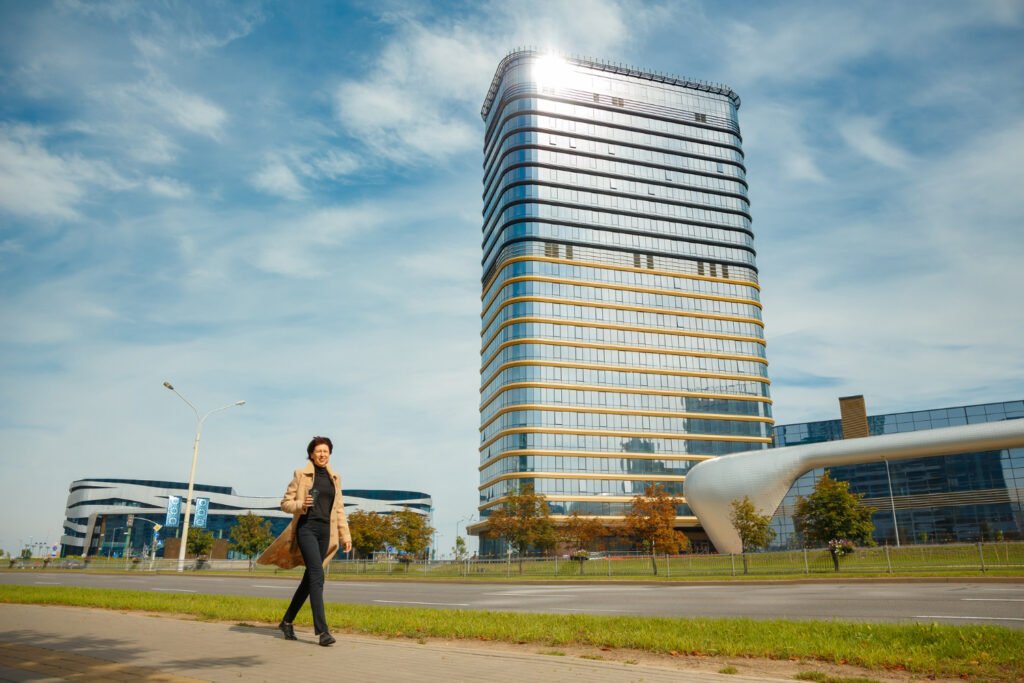The commercial real estate sector is undergoing a revolutionary transformation driven by the rapid adoption of artificial intelligence (AI) and robotics. These technologies are reshaping how buildings are constructed and managed and redefining how spaces are conceptualized to meet the evolving demands of businesses and tenants. From the initial design phase to daily operations, AI and robotics set new benchmarks for efficiency, sustainability, and tenant satisfaction.

More Brilliant Design: AI’s Role in Creating Intelligent Spaces
1. Predictive Design Powered by Data Insights
AI-driven tools enable architects and developers to design spaces anticipating tenants’ needs through advanced data analysis. These tools propose layouts that enhance usability and energy efficiency by examining demographic trends, productivity patterns, and environmental factors. For instance, AI-optimized office spaces often feature collaborative zones, improved air quality systems, and energy-saving configurations tailored to modern workforce requirements.
2. Generative Design for Optimized Blueprints
Generative design uses AI algorithms to create thousands of design options within minutes. Architects can quickly identify the most efficient and innovative solutions by setting specific goals—such as maximizing natural light or reducing construction costs. This process accelerates project timelines and ensures that every design iteration is an intelligent, data-backed decision.
3. Sustainability at the Core
AI enhances sustainability in building design by modeling energy consumption, water usage, and carbon emissions during the planning stages. Developers can incorporate renewable energy systems, energy-efficient HVAC designs, and eco-friendly materials to meet stringent environmental, social, and governance (ESG) standards. This approach ensures commercial properties align with modern sustainability expectations.
Robotics Revolutionizing the Construction Process
1. Automation for Precision and Speed
Robotics are streamlining construction by automating bricklaying, welding, and pouring concrete. These innovations reduce human error, minimize waste, and significantly cut down project timelines, leading to cost savings for developers. Companies like Fastbrick Robotics and Built Robotics spearhead these advancements, transforming traditionally labor-intensive tasks.
2. Modular Construction with Robotic Efficiency
The rise of modular construction, enabled by robotics, allows prefabricated components to be built off-site in controlled environments. These modules are then assembled on-site, reducing disruptions and expediting construction. This method is particularly effective for large-scale projects, including warehouses, retail spaces, and data centers.
3. 3D Printing: The Future of Building
Robotic 3D printing makes waves in commercial construction by creating complex structures with minimal material waste. This innovative approach reduces costs and offers a sustainable alternative to conventional building methods, appealing to developers focused on eco-friendly solutions.
Intelligent Operations: AI-Driven Building Management
1. Optimizing Space in Real Time
AI-enabled sensors provide real-time data on how tenants use spaces, allowing property managers to optimize layouts dynamically. Underutilized areas can be reimagined as coworking zones, lounges, or other tenant-focused amenities, ensuring every square foot delivers value.
2. Proactive Maintenance with Predictive AI
AI systems analyze sensor data from infrastructure like elevators and HVAC systems to predict maintenance needs before breakdowns occur. Robotics enhance this process by performing routine inspections and minor repairs, minimizing downtime and operational disruptions.
3. Energy Management for Sustainable Operations
AI-powered systems dynamically adjust lighting, heating, and cooling based on occupancy and weather conditions. By integrating with renewable energy sources, these systems reduce utility costs and carbon footprints, making commercial spaces more attractive to eco-conscious tenants and investors.
Enhancing Tenant Experiences: Personalization at Scale
AI and robotics are not just tools for efficiency; they are redefining the tenant experience by introducing unparalleled personalization.
- Customized Workspaces: AI tailors lighting and temperature settings to individual preferences, fostering productivity and comfort.
- Automated Concierge Services: Robotics manage tasks like package delivery, visitor check-ins, and even coffee orders, enhancing convenience in modern offices.
- Interactive Amenities: AI-powered fitness centers and meeting spaces offer personalized recommendations and seamless booking options, enriching the tenant experience.
Challenges to Overcome
While the benefits are compelling, integrating AI and robotics into commercial real estate comes with challenges:
- High Initial Costs: Advanced technologies demand significant upfront investments.
- Data Security: Protecting sensitive tenant data is paramount in this digital transformation.
- Skill Gaps: The industry requires trained professionals who leverage AI and robotics effectively.
The Future of Commercial Real Estate
AI and robotics have moved from being futuristic concepts to indispensable components of modern commercial real estate. These technologies drive efficiency, sustainability, and enhanced tenant experiences, setting a new standard for design and operations. For developers and investors, embracing these advancements is no longer optional but necessary for staying competitive.
The challenge lies not in deciding whether to adopt AI and robotics but in determining how effectively they can be used to create more innovative, more adaptable commercial spaces that meet the demands of a rapidly changing world.




No comment